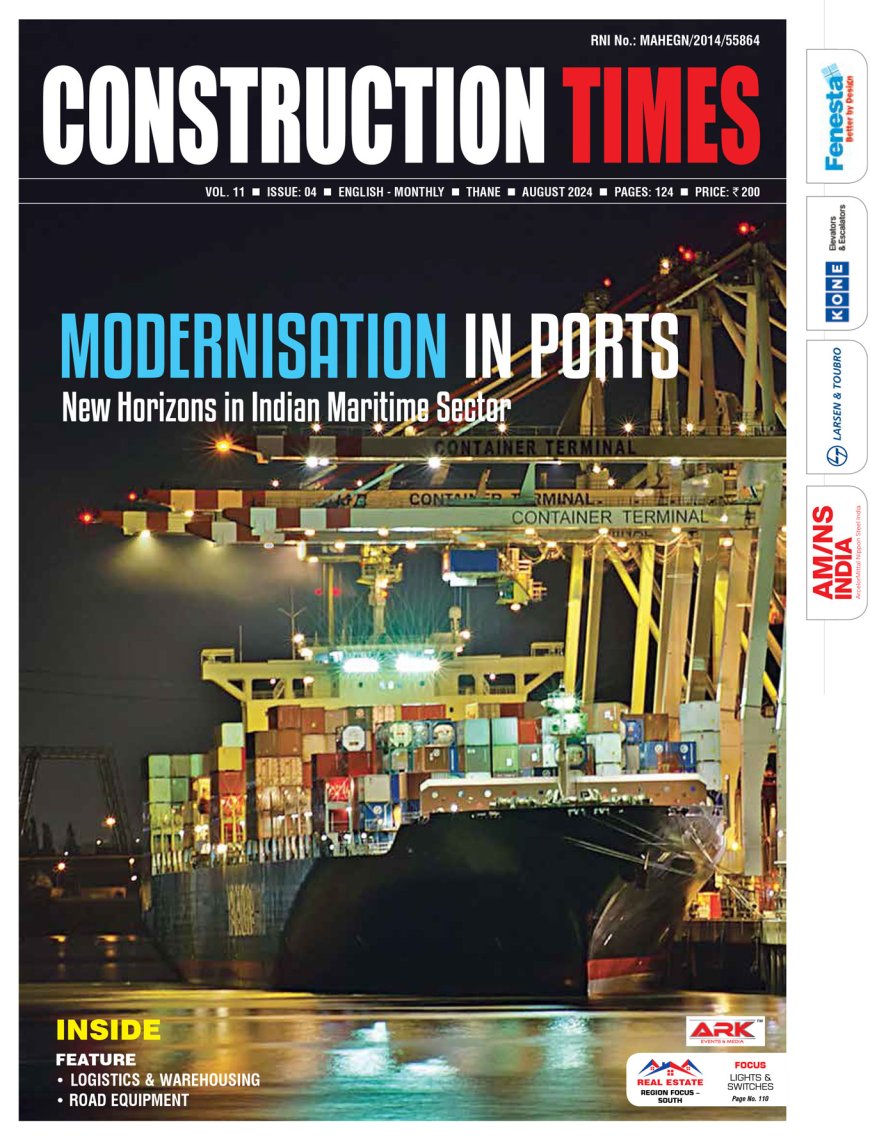On revival path

Increased policy push, coupled with the adoption of automation and technologies has revived the growth prospects of the Indian logistics and warehousing sector. But challenges prevail that need to be addressed. Construction Times explores the scenario and the way forward.
India’s logistics sector has gained a major push recently after the introduction of National Logistics Policy. The development of road and rail infrastructure has also helped improve the efficiency of logistics. With the logistics sector growing, there is a pressing need for better warehousing facilities to support the continued growth. While Indian ports are stepping up their operational efficiency, there is a need to improve the share of logistics through rail and air also to lessen the burden on roads and improve the overall efficiency and sustainability of Indian logistics sector.
Evolving trends in logistics & warehousing
According to the latest Rubix Industry Insights, the Indian logistics industry is transforming at a faster pace on the back of the recent measures of E-way bill system, PM GatiShakti National Master Plan, and the National Logistics Policy (NLP). Roads account for more than 60% share of logistics transportation. Railway freight loading grew at 5% CAGR from FY2018 to FY2024 and stood at 1,591 million tonnes (159.1 crore tonnes) in FY20243. Dedicated freight corridors are expected to play a critical role in operational efficiency. Shipping has also grown, and in FY2024, major ports, which account for nearly 55% of port traffic, handled 819 million (81.9 crore) metric tonnes of cargo traffic, recording 7% CAGR between FY2021 and FY2024.
The latest Vestian report says that H1 2024 witnessed an absorption of 16.6 million sq ft warehousing facilities, showcasing an increase of 8% over the same period a year earlier. Mumbai and Pune together accounted for 63% of the total absorption in H1 2024, followed by southern cities (Bengaluru, Chennai and Hyderabad) at 29%. NCR witnessed a significant decline in its share from 31% to 6% in the same period.
Third-party logistics (3PL) companies dominated absorption with 39% share in H1 2024. The share has increased from 26% in H1 2023. Similarly, the share of Engineering & Manufacturing and Automobiles & Auto Components sectors also saw an increase from 16% and 4% in H1 2023 to 22% and 9% in H1 2024, respectively.
Prevailing challenges

In spite of the growing market, India’s logistics and warehousing sector still facing a lot of challenges related to operations, infrastructure and other aspects. According to Neeraj Bajaj, Head – Warehousing &Distribution, CJ Darcl Logistics Ltd, there are numerous hurdles in the way of seamless warehousing. “These challenges include complex supply chains, rising costs, and faster delivery demands. Poor utilization of space and improper layout is another challenge that we expect. Maintaining proper inventory levels is another factor that one has to keep in mind. Maintaining accurate records, optimizing labour selection, and implementing the right technology is a task. To correct the course, the industry is turning to warehouse automation to ease these challenges. Automation not only decreases the costs but also makes sure that there is a slim chance of human errors.”

Darshan Ghodawat, CEO and Managing Director, AVA Global Logistics, adds, “The need for substantial investment in infrastructure and technology to keep pace with the increasing demand is an important part of this challenge. This includes the development of modern, multi-modal logistics parks and the integration of advanced automation systems. Ensuring a skilled workforce capable of managing and operating these advanced systems is another critical challenge as training and upskilling the existing workforce to handle new technologies will be essential for seamless operations.”

According to Abhijit Malkani, CEO, ESR India, the industry faces challenges such as slow rental growth, rising land prices, and scarcity of clear land titles, creating a mismatch between development costs and returns. Infrastructure gaps in some regions further complicate expansion.
Growing opportunities

In spite of many challenges, opportunities are multiplying in the current market scenario. “We anticipate increased demand from e-commerce, quick commerce, and last-mile logistics sectors, driven by rising consumer expectations for rapid deliveries and technological advancements. In-city warehousing space, capable of meeting these demands, holds significant potential. LILP ensures scalable solutions with a hassle-free experience,” says Devender Singh Rawat, CEO, Green Digital Infrastructure, Lodha.

“We see a big growth opportunity catering to the increasing demand from e-commerce and retail sectors, that require efficient and strategically located warehousing solutions to support their rapid expansion,” says Anoop Chauhan, Vice President - Contract Logistics & Cold Chain, Subcontinent, DP World.
Technology adoption

The growth in the e-commerce and retail market, coupled with the progress in manufacturing sector has pushed the use of modern technologies, digital solution and automation in warehousing and logistic operations. Anil Lingayat, Executive Vice President and Business Head, Material Handling Business of Godrej & Boyce, part of the Godrej Enterprises Group, elaborates, “We are seeing several exciting developments in the warehousing equipment sector. The integration of automation, robotics, and advanced warehouse management software plays a crucial role in boosting operational efficiency and productivity. These advancements facilitate seamless connectivity and real-time monitoring, enabling informed decision-making and optimizing resource utilization.”

According to Sandeep Chanda, Managing Director, Panattoni India, one key area is automation, with warehouses implementing technologies like robotic picking systems and automated guided vehicles (AGVs) to speed up order fulfilment and reduce reliance on manual labour. “Data is also playing a starring role. Warehouse Management Systems are optimizing storage layouts, picking routes, and inventory levels, leading to increased efficiency and reduced costs,” he adds.
Future promising

The future of India's logistics and warehousing sector looks promising, supported by several government initiatives and technological advancements. Says Aloke Bhuniya, Chief Executive Officer, Ascendas-Firstspace, “The Indian Government has been proactive in addressing logistics challenges by establishing multimodal logistics parks, aggregation and disaggregation centers, and state-of-the-art warehousing facilities. The PM Gati Shakti program is pivotal in enhancing roads, railways, ports, and airways, focusing on creating a congestion-free logistics infrastructure. Additionally, regulatory measures like the GST Act, National Logistics Policy, and warehouse standardization have significantly bolstered the sector.”

Hemant Prabhu, Chief Operating Officer, Greenbase Industrial & Logistics Parks adds, “In my opinion, Tier 1 and industrial cities remain key markets, however, it is imperative to make inroads into secondary markets, given the increasing prevalence of tier 1 & 2 cities, especially with growing ecommerce and modernisation of infrastructure which is opening up opportunities for growth in new markets.”

According to Tushar Bhaskar, Chief Business Officer, Rubix Data Sciences, the industry is projected to grow at a compound annual growth rate (CAGR) of 11% from FY2024, reaching USD 468 billion by FY2027. “Overall, the Indian logistics transportation industry is set to become more efficient, cost-effective, and globally competitive, positioning India as a crucial player in the global logistics landscape,” he concludes on a positive note.















